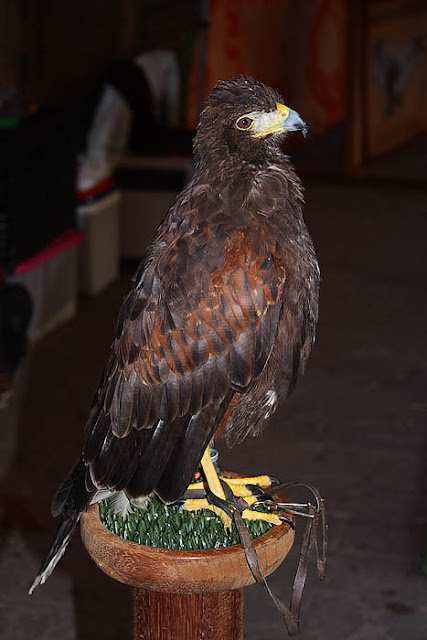The Golden Eagle (Aquila chrysaetos) belongs to the family Accipitridae. Once widespread across the Holarctic, it has disappeared from many of the more heavily populated areas, but is still present in Eurasia, North America, and parts of Africa.
.jpg) |
| Captive Golden Eagle (Aquila chrysaetos). (© LightColourShade. All rights reserved) |
 |
| Harris Hawk (Parabuteo unicinctus) (© LightColourShade. All rights reserved) |
If a bird of prey is perched on the wrong perch for extended periods of time, it can develop foot infections like bumblefoot which can be deadly to the bird. Block perches are for owls and falcons, and bow perches for other species.
 |
| Harris Hawk (Parabuteo unicinctus) perched on Arabic style block. (© LightColourShade. All rights reserved) |
 |
| Dark Brown Golden Eagle (Aquila chrysaetos) sitting on a perch. (© LightColourShade. All rights reserved) |
 |
| Harris Hawk (Parabuteo unicinctus) on Arabic style block perch. (© LightColourShade. All rights reserved) |
The Eurasian / European Eagle-Owl (Bubo bubo), aka horned owl, is a species of eagle owl resident in much of Eurasia. It is the only member of its genus besides the Snowy Owl (B. scandiacus), and is one of the largest species of owls.
Eagle Owls prefer rocky areas, especially where cliffs and ravines are surrounded by a scattering of trees and bushes, but can inhabit a wide range of habitats. They have been found in habitats as diverse as Northern coniferous forests and the edge of vast deserts.
| Eurasian Eagle Owl. (by-nc-nd) |
| Eurasian Eagle owl on Arabic style block perch. (by-nc-nd) |
| Eurasian Eagle owl in captivity. (by-nc-nd) |
| Eurasian Eagle Owl sitting on Arabic style block perch (© LightColourShade, by-nc-nd) |
This beauty was the star of the show.
The Snowy Owl (Bubo scandiacus), (spanish name búho nival), is a large owl of the typical owl family Strigidae. The adult male is virtually pure white, but females and young birds have some dark scalloping. The Snowy Owl is usually found in the northern circumpolar region, it nests in the Arctic tundra of the northermost stretches of Alaska and Canada and Eurasia and move south in winter.
 |
| Snowy Owl (Bubo scandiacus) female. (© LightColourShade. All rights reserved) |
 |
| Snowy Owl (Bubo scandiacus) female on a bow perch (© LightColourShade. All rights reserved) |
 |
| Snowy Owl (Bubo scandiacus) female sitting on a bow perch (© LightColourShade. All rights reserved) |
The Peregrine Falcon (Falco peregrinus), also known as the Peregrine, and historically as the Duck Hawk in North America, is a widespread bird of prey in the family Falconidae. As is typical of bird-eating raptors, Peregrine Falcons are sexually dimorphic, females being considerably larger than males. The Peregrine is renowned for its amazing speed, reaching over 322 km/h (200 mph) during its characteristic hunting stoop (high speed dive), making it the fastest member of the animal kingdom.
The Peregrine's breeding range includes land regions from the Arctic tundra to the tropics. It can be found nearly everywhere on Earth, except extreme polar regions, very high mountains, and most tropical rainforests; the only major ice-free landmass from which it is entirely absent is New Zealand.
This makes it the world's most widespread raptor and one of the most widely found bird species. As both the English and scientific names of this species ("wandering falcon") suggest many northern populations are migratory.
| Grey Hawk (Buteo plagiatus) (© LightColourShade, by-nc-nd) |
 |
| Peregrine Falcon (Falco peregrinus). (© LightColourShade. All rights reserved) |
 |
| Peregrine Falcon (Falco peregrinus) sitting on a bow perch (© LightColourShade. All rights reserved) |
The Spanish Imperial Eagle, Iberian Imperial Eagle or Adalbert's Eagle (Aquila adalberti) is a threatened species of eagle that only occurs in central and south-west Spain and adjacent areas of Portugal. Unfortunately this magestic bird was wearing a hood, so I couldn't see its head.
 |
| Spanish Imperial Eagle, Iberian Imperial Eagle, Adalbert's Eagle (Aquila adalberti). (© LightColourShade. All rights reserved) |
You know, I've been waiting for this post. It was wonderful, but I couldn't help wondering what must those birds be like in the wild! Just magnificent.
ReplyDeleteThat's exactly my dream -- to watch these birds fly in the wild... and take pictures if possible ;)
ReplyDeleteI believe your Golden Eagle to be a Harris' Hawk. Golden Eagles do not look like this; they are a chocolate brown with slightly golden tints on the shoulder of the wing and back of the head. Harris' Hawk is dark with a brown patch on the wing. The white band on the tail is a Harris' feature too, you never see this on Golden Eagle.
ReplyDeleteYou're right about # 2,3,5 -- it's Harris Hawk (Parabuteo unicinctus), but # 1 and 4 is juvenile Golden Eagle, it doesn't have the white ring on the tip of the tail, it also has tarsal feathers that range from white to dark brown while Harris' hawk doesn't.
Delete